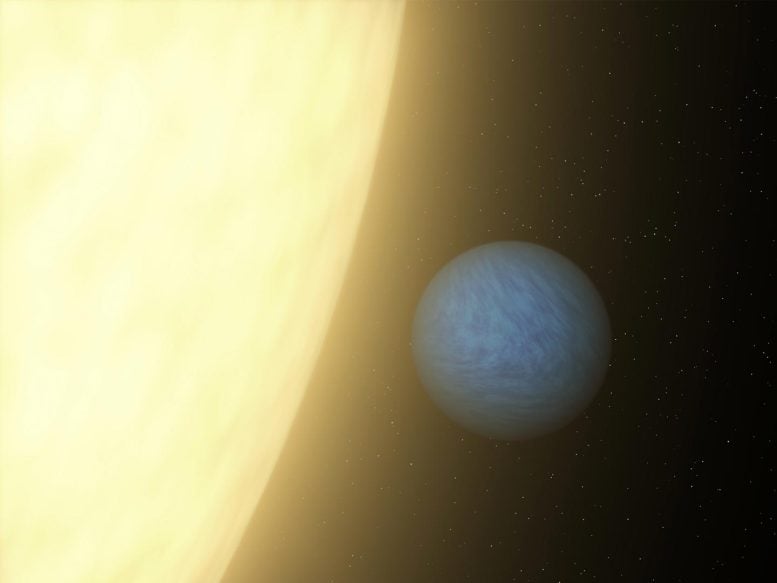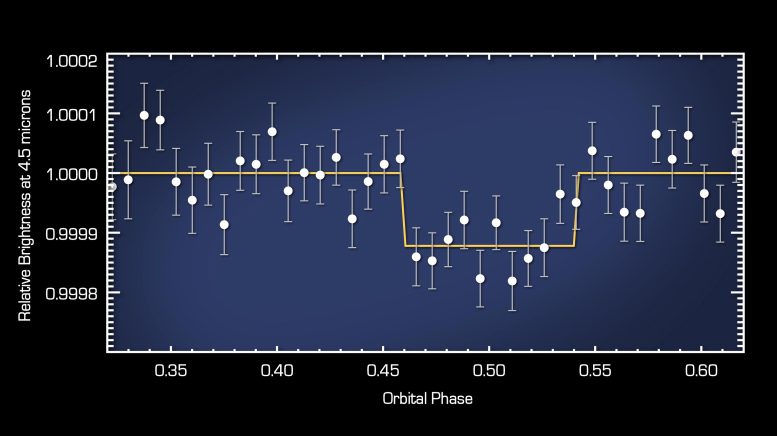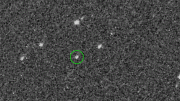
Data from the Spitzer Space Telescope reveals that 55 Cancri e is very dark, and that its sun-facing side is blistering hot. Credit: NASA/JPL-Caltech
Sitting 40 million light-years away, researchers were able to gain a better understanding of 55 Cancri e and its environment. Using observations from NASA’s Spitzer Space Telescope, the team found that its temperature is roughly 2,360 degrees Kelvin and that 55 Cancri e orbits its star much like the moon circles Earth.
Scientists on a planetary-heat-seeking mission have detected the first infrared light from a super-Earth — in this case, a planet some 40 light-years away. And according to their calculations, 55 Cancri e, a planet just over twice the size of Earth, is throwing off some serious heat.
At a toasty 3,700 degrees Fahrenheit (2,000 degrees Celsius), the planet is hot enough to liquefy steel. And there’s not much relief from the scorching heat: Researchers at MIT and other institutions say the planet may lack reflective surfaces such as ice caps, instead absorbing most of the heat from its parent star — much as Earth’s dark oceans trap heat from the sun.
NASA’s Spitzer Space Telescope has, for the first time, captured the light emanating from a distant super Earth, a planet more massive than Earth but lighter than Neptune. Credit: NASA
Since the planet’s discovery in 2004, scientists have unearthed a number of its properties; the new findings, published in the current issue of Astrophysical Journal Letters, expand the physical profile of 55 Cancri e. The planet orbits the star 55 Cancri, part of the crablike constellation Cancer, which is bright enough to be seen with the naked eye.
Using telescopes on the ground and in space, scientists examine light patterns from a star to determine the traits of any planets around it. Periodic dips in starlight indicate that a planet has transited, or passed in front of, its star. From this data, scientists have now calculated 55 Cancri e’s radius (twice that of Earth’s) and the duration of its orbit (18 hours, versus our leisurely 365 days).
While the stellar brilliance enables researchers to detect changes in starlight, it’s much trickier to detect light of any wavelength — visible or infrared — from the planet itself.
“This planet is so close to the star that it’s very strongly irradiated,” says co-author Brice-Olivier Demory, a postdoc in MIT’s Department of Earth, Atmospheric and Planetary Sciences. “It’s like in the movie ‘Avatar,’ where Pandora orbits the gas giant Polyphemus. Seeing Polyphemus from Pandora gives an idea of how big the star would look from 55 Cancri e.”
Demory says isolating the heat of the planet from the massive heat emitted from its star would be like detecting the heat of one candle among an array of 10,000.

This plot of data from NASA’s Spitzer Space Telescope reveals the light from a “super Earth” called 55 Cancri e. Credit: NASA/JPL-Caltech/MIT
Super-hot super-Earth
Undaunted by such a task, Demory worked with Sara Seager, the Class of 1941 Professor of Physics and Planetary Science at MIT, and researchers from the MIT Kavli Institute for Astrophysics and Space Research, the University of Maryland, Washington’s Carnegie Institution and the University of Liege in Belgium to detect the planet’s thermal emissions.
The group obtained observations from NASA’s Spitzer Space Telescope, which monitors infrared radiation emitted by objects in the solar system and beyond. Demory and his colleagues trained the telescope on 55 Cancri, observing the star during a six-hour window during which the tiny exoplanet passed behind it — a phenomenon known as an occultation.
Demory measured the starlight before and after the planet’s occultation, discovering a minute dip when the star completely eclipsed the planet. To make sure the dip wasn’t merely a fluke, the team obtained three more sets of data for the same orbital window, and analyzed all four datasets together.
“When you stack all the data together, you see a beautiful dimming light that clearly shows the light from the planet that disappears,” says co-author Michael Gillon, principal investigator of the Spitzer telescope program. “This is the first time that we see light from a planet that is that small.”
From the planet’s infrared light, the researchers precisely calculated its temperature — a scorching 2,360 degrees Kelvin, or 3,700° F. With such high temperatures, Demory posits that the planet is likely rather dark, having no reflective surfaces such as ice caps, and probably absorbs most of the heat given off by its star.
The planet’s temperature may also give researchers a clue about its atmosphere. 55 Cancri e orbits its star much like the moon circles Earth, always presenting the same face. Demory suspects that much of 55 Cancri e’s heat remains on the “day side” of the planet, and that it would be difficult to circulate such high temperatures to the planet’s dark side: In other words, it’s unlikely that the super-hot planet harbors any strong winds.
Phil Armitage, an associate professor of astrophysics at the University of Colorado, says it’s extremely difficult for any instrument — including the Spitzer telescope — to make a direct detection of an exoplanet. He sees the group’s detection as “a great example of really pushing an instrument to its limits.”
He adds that the planet’s infrared light will help identify more characteristics from this particular super-Earth.
“Super-Earths are fascinating objects because they don’t have any analogs in the solar system,” Armitage says. “We don’t have a clear idea how they formed or even what they’re made of. It’s a mystery that requires data beyond the planet’s mass and radius to resolve.”
Going forward, Demory hopes to obtain more data to map the planet’s infrared light as it completes an orbit around its star. The results could illuminate the different phases of the planet as it circles the star, similar to the waxing and waning of Earth’s moon.
Seager says that in addition to fleshing out the physical profile of 55 Cancri e, the group’s techniques may be adopted to characterize other exoplanets in the universe — even, perhaps, those as small as Earth.
“We’re pushing toward smaller and smaller planets with techniques that are already established,” Seager says. “Once you discover one, you want to find more. And there are a lot of exoplanets out there.”
The research is based on observations made with the Spitzer Space Telescope, which is operated by the Jet Propulsion Laboratory (JPL) and the California Institute of Technology under a contract with NASA. Support for this work was provided by NASA through an award issued by JPL/Caltech.









Be the first to comment on "Revealing Data from Super-Earth 55 Cancri e"